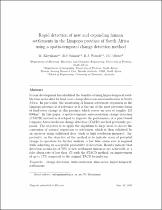 ResearchSpace
ResearchSpace
Rapid detection of new and expanding human settlements in the Limpopo province of South Africa using a spatio-temporal change detection method
JavaScript is disabled for your browser. Some features of this site may not work without it.
- ResearchSpace
- →
- Research Publications/Outputs
- →
- Journal Articles
- →
- View Item
| dc.contributor.author |
Kleynhans, W

|
|
| dc.contributor.author |
Salmon, BP

|
|
| dc.contributor.author |
Wessels, Konrad J

|
|
| dc.contributor.author |
Olivier, JC

|
|
| dc.date.accessioned | 2015-08-19T11:03:30Z | |
| dc.date.available | 2015-08-19T11:03:30Z | |
| dc.date.issued | 2015-08 | |
| dc.identifier.citation | Kleynhans W, Salmon BP, Wessels KJ and Olivier JC. 2015. Rapid detection of new and expanding human settlements in the Limpopo province of South Africa using a spatio-temporal change detection method. International Journal of Applied Earth Observation and Geoinformation, Vol .40, pp. 74-80 | en_US |
| dc.identifier.issn | 0303-2434 | |
| dc.identifier.uri | http://www.sciencedirect.com/science/article/pii/S0303243415000884 | |
| dc.identifier.uri | http://hdl.handle.net/10204/8075 | |
| dc.description | Copyright: 2015 Elsevier. Due to copyright restrictions, the attached PDF file only contains the abstract of the full text item. For access to the full text item, please consult the publisher's website. The definitive version of the work is published in the International Journal of Applied Earth Observation and Geoinformation, Vol .40, pp. 74-80 | en_US |
| dc.description.abstract | Recent development has identified the benefits of using hyper-temporal satellite time series data for land cover change detection and classification in South Africa. In particular, the monitoring of human settlement expansion in the Limpopo province is of relevance as it is the one of the most pervasive forms of land-cover change in this province which covers an area of roughly 125 000 km2. In this paper, a spatio-temporal autocorrelation change detection (STACD) method is developed to improve the performance of a pixel based temporal Autocorrelation change detection (TACD) method previously proposed. The objective is to apply the algorithm to large areas to detect the conversion of natural vegetation to settlement which is then validated by an operator using additional data (such as high resolution imagery). Importantly, as the objective of the method is to indicate areas of potential change to operators for further analysis, a low false alarm rate is required while achieving an acceptable probability of detection. Results indicate that detection accuracies of 70% of new settlement instances are achievable at a false alarm rate of less than 1% with the STACD method, an improvement of up to 17% compared to the original TACD formulation. | en_US |
| dc.language.iso | en | en_US |
| dc.publisher | Elsevier | en_US |
| dc.relation.ispartofseries | Workflow;15107 | |
| dc.subject | Change detection | en_US |
| dc.subject | Autocorrelation | en_US |
| dc.subject | Time-series | en_US |
| dc.subject | Hyper-temporal | en_US |
| dc.subject | Settlements | en_US |
| dc.title | Rapid detection of new and expanding human settlements in the Limpopo province of South Africa using a spatio-temporal change detection method | en_US |
| dc.type | Article | en_US |
| dc.identifier.apacitation | Kleynhans, W., Salmon, B., Wessels, K. J., & Olivier, J. (2015). Rapid detection of new and expanding human settlements in the Limpopo province of South Africa using a spatio-temporal change detection method. http://hdl.handle.net/10204/8075 | en_ZA |
| dc.identifier.chicagocitation | Kleynhans, W, BP Salmon, Konrad J Wessels, and JC Olivier "Rapid detection of new and expanding human settlements in the Limpopo province of South Africa using a spatio-temporal change detection method." (2015) http://hdl.handle.net/10204/8075 | en_ZA |
| dc.identifier.vancouvercitation | Kleynhans W, Salmon B, Wessels KJ, Olivier J. Rapid detection of new and expanding human settlements in the Limpopo province of South Africa using a spatio-temporal change detection method. 2015; http://hdl.handle.net/10204/8075. | en_ZA |
| dc.identifier.ris | TY - Article AU - Kleynhans, W AU - Salmon, BP AU - Wessels, Konrad J AU - Olivier, JC AB - Recent development has identified the benefits of using hyper-temporal satellite time series data for land cover change detection and classification in South Africa. In particular, the monitoring of human settlement expansion in the Limpopo province is of relevance as it is the one of the most pervasive forms of land-cover change in this province which covers an area of roughly 125 000 km2. In this paper, a spatio-temporal autocorrelation change detection (STACD) method is developed to improve the performance of a pixel based temporal Autocorrelation change detection (TACD) method previously proposed. The objective is to apply the algorithm to large areas to detect the conversion of natural vegetation to settlement which is then validated by an operator using additional data (such as high resolution imagery). Importantly, as the objective of the method is to indicate areas of potential change to operators for further analysis, a low false alarm rate is required while achieving an acceptable probability of detection. Results indicate that detection accuracies of 70% of new settlement instances are achievable at a false alarm rate of less than 1% with the STACD method, an improvement of up to 17% compared to the original TACD formulation. DA - 2015-08 DB - ResearchSpace DP - CSIR KW - Change detection KW - Autocorrelation KW - Time-series KW - Hyper-temporal KW - Settlements LK - https://researchspace.csir.co.za PY - 2015 SM - 0303-2434 T1 - Rapid detection of new and expanding human settlements in the Limpopo province of South Africa using a spatio-temporal change detection method TI - Rapid detection of new and expanding human settlements in the Limpopo province of South Africa using a spatio-temporal change detection method UR - http://hdl.handle.net/10204/8075 ER - | en_ZA |





